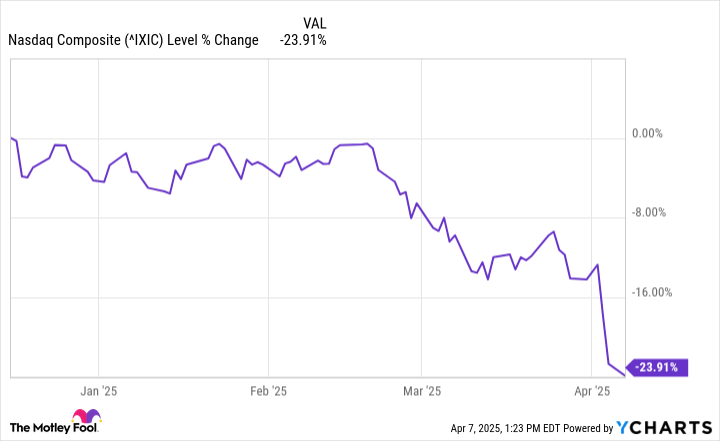The Nasdaq Composite Enters Bear Market: What Investors Should Know
In a significant market development, the Nasdaq Composite has officially entered bear territory, declining over 20% from its recent high. As of now, the index is approximately 24% down from its peak on December 16, raising concerns among investors about future performance.
Impact of Tariff Announcements on the Nasdaq
The deterioration of the Nasdaq Composite was exacerbated by President Donald Trump’s recent announcement of a new tariff plan on April 2. This plan impacts imports from around 180 countries, leading to elevated costs on various goods, particularly those vital to the technology sector—home to many of the largest companies in the Nasdaq Composite.
Investment Opportunities Amid Market Challenges
Despite the bear market, it is essential not to overlook potential investment opportunities within the Nasdaq. One such option is the Direxion Nasdaq-100 Equal Weighted Index ETF (NASDAQ: QQQE). This ETF may offer a valuable strategy for long-term investors looking to position themselves favorably in a fluctuating market.
Understanding the Direxion ETF Structure
While the Direxion ETF does not encompass every stock in the Nasdaq Composite, it focuses on the Nasdaq-100, which includes the 100 largest nonfinancial companies. What sets this ETF apart is its equal-weighted structure, which distributes investments evenly across all companies in the Nasdaq-100. This contrasts with traditional market cap-weighted ETFs, where larger companies dominate the investment landscape.
The Heavy Influence of Megacap Tech Stocks
The Nasdaq-100 is heavily influenced by a small number of megacap tech stocks, often referred to as the “Magnificent Seven”—Apple, Nvidia, Microsoft, Amazon, Meta Platforms, Alphabet, and Tesla. Together, these seven companies account for over 45% of the index, meaning their performance significantly affects the overall movement of the Nasdaq Composite.
Diversification Through the Equal Weighted Approach
Although the technology sector remains the largest within the Direxion ETF, its equal weighting reduces the concentration risk often analyzed in standard indices. For instance, the information technology sector accounts for 40.65% of the equal-weighted ETF compared to 51.29% in the traditional Nasdaq-100. This diversification is essential for investors seeking a balanced approach during economic fluctuations.
Performance and Future Considerations
Since its inception in March 2012, the Direxion Nasdaq-100 Equal Weighted Index ETF has delivered impressive returns, averaging 11% annually over 13 years, even outperforming the S&P 500 during this period. These returns reflect the growth potential inherent in an equal-weighted investment strategy, which may help investors navigate future market challenges with less volatility.
Conclusion: Should You Invest in the Direxion ETF?
While the Direxion Nasdaq-100 Equal Weighted Index ETF can enhance portfolio diversification and reduce concentration risk, it should not dominate your investment strategy. Investors should remain aware of emerging opportunities in the market, with experts recommending a balanced approach that encompasses a variety of sectors. Conduct thorough research or consult with a financial advisor to determine the best course of action for your investment portfolio.
This structured HTML article is designed for readability, incorporating relevant heading tags and maintaining an engaging flow of information, making it appealing for search engines and readers alike.
